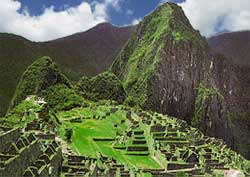machu picchu
 Why
Machu Picchu is special
Why
Machu Picchu is specialMost seasoned travelers agree that Machu Picchu in Peru is the world's most dramatic ruins. It sits boldly perched on a steep sided mountain saddle far above the partially encircling Urubamba River gorge.
What remains of the precision stonework of the pre-Colombian Inca temples and palaces clearly reveals how exalted Machu Picchu was in its glory days.
Best and worst times to visit Machu Picchu - The two tourism seasons
-
May to September
This is the best period. May is the prettiest month (the dense, subtropical mountain forests are exceptionally green) while August is the best all around month.
- October to April
The is the rainy season and therefore the least desirable period.
Mysteriously abandoned
Just before the Spanish conquest, Machu Picchu was mysteriously abandoned - and this was when it was still in its golden age.
Unknown to the Spaniards
The conquering Spanish were unaware of Machu Picchu. Its existence was known only by local insiders.
Discovery
Machu Picchu lay buried under dense mountainous vegetation until 1911 when Yale University explorer Hiram Bingham discovered it and began the reclamation process.
Getting to Machu Picchu
First stage
Nearly all tourists begin their adventure by flying from Lima to the city of Cuzco (1 hour 15 minutes). They then stay overnight in Cuzco before embarking on their journey to Machu Picchu.
Second stage
You have three options for traveling to Machu Picchu from Cuzco:
-
Train
You catch an early morning 3-hour train to a river-level village at the base of the ruins. You then transfer to a bus that zig-zags up a steep 2,000 foot high mountain slope to reach the Machu Picchu site (30 minutes).
- Hiking
You can also hike from the Cuzco area to Machu Picchu on a network of ancient paths collectively named the Inca (or Inka) Trail. The journey takes 2 to 10 days, depending on your speed and choice of paths.
- Helicopter
There is service between Cuzco and Aqua Calientes (near Machu Picchu).
Day-trip drawback
You'll have more hours to enjoy and explore the ruins if you stay overnight at the hotel located next to the ruins or (less expensively) at one situated in nearby Aqua Calientes. You will be able to explore this travel wonder in the late afternoon and early the next morning when the tourist count is low. Rooms are scarce, so book well ahead.
Overnight-stay benefit
You'll have more hours to enjoy and explore the ruins if you stay overnight at the hotel located next to the ruins or (less expensively) at one situated in nearby Aqua Calientes. You will be able to explore this travel wonder in the late afternoon and early the next morning when the tourist count is low. Rooms are scarce, so book well ahead.
Precision stonework
The huge granite stone building blocks were hewn so precisely that they fit tightly together by themselves. No mortar or other adhesive was used. You cannot even insert a thin blade between their joints.
Climbing Huayna Pcchu can be hazardous
It's the sharp peak immediately behind the ruins (see photo on page one). The reward is a spectacular view of Machu Picchu below you. However, be fit and sure footed as the ancient stone steps to the top are steep and primitive. If you do climb the peak, avoid inclement weather as the stones could be slippery. And, in 2004, a visitor was struck by lightning when he reached the summit.


